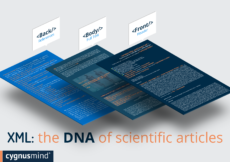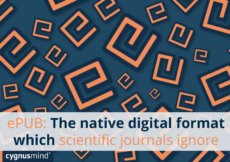www.cygnusmind.com
The Digital Publication is not only a PDF – CygnusMind´s Blog
by Cygnusmind.com
ARTICLE
The evaluation of scientific journals by Peer Review exists since the 15th century. When The Royal Society published the Philosophical Transactions A y B. Nowadays, this journal is stills being published and is the oldest journal. Furthermore, is one of the most prestigious and influential. For this subject, in the context of scientific journals publishing, we can illustrate with Plos, e-Life, among others.
Speaking about the digital publication of scientific journals, let’s analyze the Iberoamerican context: the digital transition or the scientific journal uploading has enhanced over time. According to Latindex data, in 2006, there were 1,735 uploads. In 2018, the amount was 8,175 which represents an annual growth of around 500 online journals.
Registered journals in Latindex Directory amount to 26,000 whose 31% is online. Is enough with that number? In our opinion the proportion is small: one in three. Furthermore, if we explore the conditions of the pages, we may see strong problems as lack of update; which affects PDF format, among others. They are online but many of them lack adequate technological resources which present several different technological solutions and techniques used by journals. Being online registered do not define being updated.
| The main argument of this article is to emphasize that online journals, or rather digital publishing has not been as successful as it supposed to be. The reason is, overall, printed publication has wanted to carry – copy and replicate the document – into the digital world. To illustrate, PDF files have been worked for several years for this purpose; its advantages are little by little fewer than disadvantages. Nevertheless, our proposal is that a digital publication can only reach its full potential when is separated from atavisms from the printed production process. |
Our experience through the years of working with different publishers is that digital journal could only have success if its PDF’s stand out in their domains, with the purpose of think about the enormous possibilities offered currently by digital world.
Let’s enlist some of the main ideas to distinguish what a digital journal is from one that is not.
The limits of PDF are clear:
〉It does not have necessary hyperlinks
〉It cannot be totally inserted multimedia files
〉 It is not allowed to move dynamically through the sections of the article
〉It does not allow an immediate global view of the work
〉 It not possible, most of times, to get the whole text in a transparent way
〉 It is not guaranteed the conservation of works
〉 It does not possess an open source
〉 Is not a responsive format [adaptation in different screen layout and devices]
〉 GIFs placement is impossible
A digital journal is characterized by::
〉Having not printed pages
〉Having not a pagination
〉Not presenting a current frequency of periodicity, which is, paradoxically, opposite to the purpose of being a recurrent publication
〉Possessing a limit of printed pages more than the 20 to 25 pages which can and should be passed
〉Having not a specific limit to incorporate and integrate different elements – parts– of the academic discourse like data, formulas, photos, etc.
〉Differentiating itself from a PDFF
〉Not demanding a linear reading
〉Antistatic text and images
〉Not prioritizing a preview view and a structured design in the message transmission speede
〉 Having a world digital vision, not a local digital vision
〉 Prioritizing subscriptions, not only the links and downloads links
〉 Not having a barter-trade
〉 Not possessing sections
〉 Not defining the importance based on the number of subscriptions
|
PDF: Can be downloaded and offers offline reading. |
|||
|
In digital context, the portability can be shown in two manners: 1. By downloading the e-PUB link into your technological device. Is low-cost, is adaptable in any screen and can be shared with anyone. 2. Downloading the HMTL link into an offline reading system such as Pocket, EverNote, etc. It can be read without internet Connection as well as it is adaptable the size and name of the letters. |
|||
|
PDF: Designing is customized professionally and can be printed. |
|||
|
Printing is a resource commonly less used today. In cases where is needed it, it exists the called printer-friendly PDF format. Fixed design is a bad habit since the time of Gutenberg; is quite difficult to take advantage of the reading. |
|||
|
PDF: The page is high important to make citation correctly because is that what we want in scientific research. |
|||
|
In the digital world, to cite the number of pages is totally unnecessary. Let’s mention some of them: 1. It does not exist paging because it changes in every format file. 2. Paging had a meaning in Gutenberg’s time when it was hard to find orientation to identify context and learn beyond the file. Nowadays, with such powerful search engines we have access to citation only typing three words between quotation marks, or with a + sign. Furthermore, some styles and formats like APA allow make citation instantly without cite the pages. |
|||
|
PDF: Can contain comments as well make notes and underlining. |
|||
|
In any reading system we can make underlining or add comments. In some systems, the underlining is saved in a “private library”. In other cases, underlining or selected text may be shared in social networks almost instantly. |
|||
|
PDF: The socio-scientific networks [Mendeley-ResearchGate-Academia] use it due to its easily transmission. |
|||
|
We should not confuse customs and practices with real advantages of transmission. In all academic publishing areas is must be moved the information into the digital publishing. |
|||
|
PDF: The equations or mathematical formulas are shown fidelity. |
|||
|
Fidelity versus Replicability? The concept of fidelity of a formula in digital context is refereed to the capacity of reproduce it, the capacity of establish the adequation of the data and conclusions results. Is not enough to know it, is compulsory that we have to replicate the process; to attach the new databases. |
The farewell to PDF
In that sense, there exist well known recognized digital reading system besides the typical speed, the “low-cost” and the relatively easy reading.
〉The full text searches
〉The widening and handling of images, videos, graphics, tables, etc.
〉The immediate consulting link -the articulation- of references, mentions, etc. In a word, the immediate access to the digital environment with sound, video, color, images, context, etc.
〉The Identification – the comparison – and validation of data source, arguments or facts, which are not in the references. We insist in this is not a semantic perspective; is a radically different conception of meanings and senses.
〉The authors are identifiable and can be follow with theirs ORCID or theirs links in Redalyc or web site.
〉 …
Many are the advantages of the real migration to the digital journal. We want to enlist two of them whose details we will explain in future articles. Those advantages are not detailed here because, in our opinion, they are qualitative background changes.
We are referring to:
1. The continuous posting.
2. The participation of research actors in the different stages of the publication process.
But if we speak only about the advantages without the challenges, we will be partial:
A. Is an irreversible decision. When is made it, there exists the risk of not being able to stay with the latest technology, that is to say, start with great energy but a little resistance, given a result of technological lag in the medium term.
B. Is an investment in the long run is much more efficient and economical for all the advantages that are achieved in decreasing costs, avoiding wasting time and money. However, we cannot deny the investment in the latest technological advances that is inevitable.
C. The transition by whom? Is one of the greatest decisions to make. We would not be inclined to favor any specific actor involved (publisher, institution or consultant). We must have an idea od the cost, time investment, resources, and the personal immersed into processes of management and realization of academic publication. All these aspects must be assessed.
How to cite this article: Cygnusmind (2019). The Digital Publication is not only a PDF. Retrieved from Cygnusmind´s Blog: https://www.cygnusmind.com/blog/en/article/the-digital-publication-is-not-only-a-pdf/




